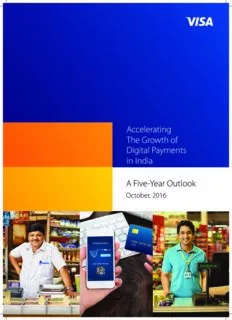
Visa Booklet opt 1 Final Layout_V24 PDF
Preview Visa Booklet opt 1 Final Layout_V24
Accelerating The Growth of Digital Payments in India A F ive-Year Outlook October, 2016 Accelerating The Growth of Digital Payments in India: A Five-Year Outlook Preface Over the past two decades, India has pushed hard to become a less–cash society. In the early 1990s, the Reserve Bank of India spearheaded the development of technological infrastructure that facilitated the creation of a payment and settlement ecosystem. In 2007, the Indian Parliament passed the Payment and Settlement Systems Act, after which the central bank released a series of vision documents for the periods of 2009–12, 2012–15, and 2015–18¹. These papers were supplemented by initiatives to promote wider acceptance and deeper penetration of electronic payments in India. The Government of India has encouraged the shift to a less–cash society with its push for digital payments through the JAM Trinity: the Prime Minister’s Jan-Dhan Yojana, Aadhaar, and mobile connectivity. We welcome the government’s efforts, including the short and medium-term measures outlined in the Office Memorandum of February 29, 2016, to accelerate the adoption of digital payments. To understand better how the country might benefit from increased digitisation of payments, this study endeavours to estimate the cost of cash to the Indian economy, and the possible gains from reducing the cost of cash over the next five years. The report also discusses policies and practices adopted by countries like Indonesia, South Korea, the United Kingdom, and Uruguay to help transition to a less–cash society. Based on these experiences, and taking into account the proposed measures and state of play, we propose a roadmap for India to achieve its goal of increasing the penetration of digital payments in the future. In doing so we layout stretch aspirations for the country. We held consultations with eminent experts in this field during the course of our work, and would like to thank Ashish Aggarwal, consultant; Suyash Rai, senior consultant; and Professor Kavita Rao of the National Institute of Public Finance and Policy. We are also grateful to the following people for their generous input: Dr. Rajesh Shukla, the managing director and chief executive officer of People Research on India’s Consumer Economy, for sharing proprietary household-level data on savings and expenditure from the Indian Consumer Economy Survey, 2013-14; Dr. M.S. Sriram, distinguished fellow, Institute for Development and Banking Research in Technology, and visiting faculty, Centre for Public Policy, Indian Institute of Management, Bangalore; Gopalaraman Padmanabhan, former executive director, Reserve Bank of India; Ashok Chawla, former finance secretary, Government of India; and Mukesh Sadana, a payments industry expert. In addition, we would like to thank colleagues at Axis Bank, HDFC Bank, State Bank of India, ICICI Bank, and Shishir Gupta and Jyoti Sekhsaria from McKinsey & Company. We appreciate the efforts of the team from PricewaterhouseCoopers in conducting detailed research and analysis for the cost of cash model. We hope this report will help enrich the ongoing policy dialogue on electronic payments in India, and provide the Ministry of Finance and the Reserve Bank of India with relevant ideas, and insights to shape the future of the country’s digital payments industry. Sincerely, TR Ramachandran Group Country Manager India & South Asia ¹ Department of Payment and Settlement Systems, Reserve Bank of India. (2018). Payment systems in India: Vision 2018 Acknowledgment The vision of Digital India, a flagship programme of the Government of India, is to promote mobile and digital banking to spur financial inclusion at scale. To achieve this vision, we are undertaking various measures to transition to a less-cash society. Achieving this goal would not only help reduce the size of the shadow economy in our country and the circulation of black money, but also lead to a significant increase in jobs. I am glad Visa has undertaken this effort to produce a fact base on the cost of cash, and to outline a roadmap to transition India to a less-cash economy. It is an opportune time. The report will contribute to the stakeholder dialogue under way on this important matter. I am glad to have the opportunity to release this report. Sincerely, Amitabh Kant Chief Executive Officer National Institute for Transforming India (NITI) Aayog Government of India 5 October, 2016 Contents Executive Summary . ....................................................................................... 05 An estimation of India’s cost of cash ...................................................................... 17 Key impediments to the growth of digital payments.................................................... 29 Three pillars to accelerate the adoption of digital payments............................................ 37 Conclusion .................................................................................................. 59 Appendix 1.................................................................................................. 61 Appendix 2.................................................................................................. 67 Bibliography................................................................................................. 73 Executive Summary
Description: